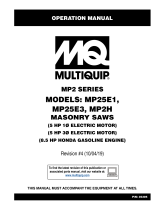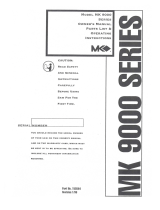
PAGE 10 — FCG16HA SAW • OPERATION AND PARTS MANUAL — REV. #1 (03/19/10)
RULES FOR SAFE OPERATION
General Safety
■
ALWAYS read, understand, and follow procedures in
Operator's Manual before attempting to operate equipment.
■
ALWAYS be sure the operator is familiar with proper safety
precautions and operating techniques before using the saw.
■
NEVER leave the machine
unattended
while running.
■
Apply the brakes when leaving or when using on a slope.
■
Maintain this equipment in a safe operating condition at all
times.
■
ALWAYS stop the engine before servicing, adding fuel and
oil.
■
NEVER run the engine without the air filter. Severe engine
damage could occur.
■
ALWAYS service air cleaner frequently to prevent carburetor
malfunction.
■
AVOID wearing jewelry or loose fitting clothing that may snag
on the controls or moving parts, this can cause a serious
injury.
■
ALWAYS keep clear of
rotating
or
moving parts
while the
saw is in operation.
■
No one other than the operator is to be in the working area
when the saw is in operation.
■
Always observe all applicable compulsory regulations
relevant to environmental protection, especially, fuel storage,
the handling of hazardous substances, and the wearing of
protective clothing and equipment. Instruct the user as
necessary, or, as the user, request this information and
training.
■
ALWAYS store equipment properly when it is not being used.
Equipment should be stored in a clean, dry location out of
the reach of children.
Diamond Blade Safety
■
Use appropriate steel centered diamond blades
manufactured for use on concrete saws. See further blade
information on pages 21 through 23.
■
ALWAYS keep the work area well organized.
■
ALWAYS Clear the cutting area of any debris, tools, etc. that
would constitute a hazard while the saw is in operation.
ALWAYS inspect diamond blades
before each use. The blade should
exhibit no cracks, dings, or flaws in the
steel centered core and/or rim. Center
(arbor) hole must be undamaged and
true. All damaged blades must be
discarded.
ALWAYS check to make sure that the
operating area is clear before starting the
engine.
WARNINGWARNING
WARNINGWARNING
WARNING
■
Examine blade flanges for damage and excessive wear.
■
Ensure the cleanliness of the blade before blade is installed.
Blade should fit snugly on the shaft and against the inside/
outside blade flanges.
■
Ensure the blade is marked with an operating speed greater
than the spindle speed of the saw.
WARNINGWARNING
WARNINGWARNING
WARNING
■
ALWAYS keep blade guards in place. Exposure of the
diamond blade must not exceed 180 degrees.
■
Ensure that the diamond blade does not come into contact
with the ground or surface during transportation. DO NOT
drop the diamond blade on ground or surface.
■
The engine governor is set to regulate maximum engine
speed in a no-load condition. Do not tamper with the engine
governor to increase the speed. Increasing the engine speed
could allow the maximum rated spindle speed to be
exceeded, creating an unsafe condition.
■
Ensure that the blade is mounted for proper operating
direction. (See Figure 12)
■
Adhere to the Blade Manufacturer's recommendations on
handling, storage, and safe usage of blades.
Only cut the material that is specified for the diamond blade.
Read the specifications of the diamond blade to ensure
the proper tool has been matched to the material being cut.
The saw has been engineered for DRY CUTTING. Ensure
a DRY CUTTING blade is being used.
WARNINGWARNING
WARNINGWARNING
WARNING


































